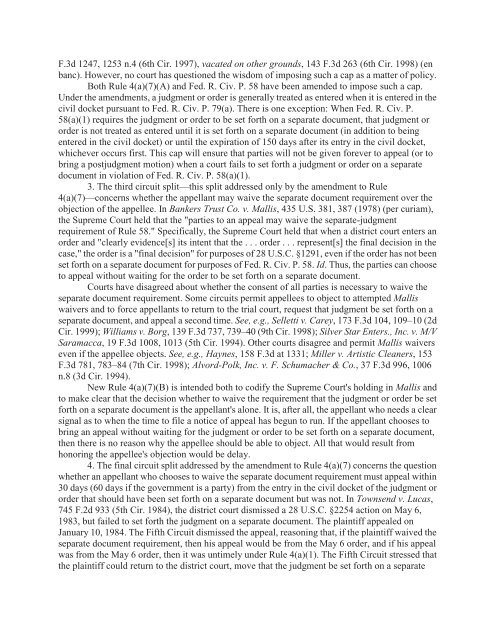Federal Rules of Appellate Procedure 2014-2015, 2014a
Federal Rules of Appellate Procedure 2014-2015, 2014a
Federal Rules of Appellate Procedure 2014-2015, 2014a
Create successful ePaper yourself
Turn your PDF publications into a flip-book with our unique Google optimized e-Paper software.
F.3d 1247, 1253 n.4 (6th Cir. 1997), vacated on other grounds, 143 F.3d 263 (6th Cir. 1998) (en<br />
banc). However, no court has questioned the wisdom <strong>of</strong> imposing such a cap as a matter <strong>of</strong> policy.<br />
Both Rule 4(a)(7)(A) and Fed. R. Civ. P. 58 have been amended to impose such a cap.<br />
Under the amendments, a judgment or order is generally treated as entered when it is entered in the<br />
civil docket pursuant to Fed. R. Civ. P. 79(a). There is one exception: When Fed. R. Civ. P.<br />
58(a)(1) requires the judgment or order to be set forth on a separate document, that judgment or<br />
order is not treated as entered until it is set forth on a separate document (in addition to being<br />
entered in the civil docket) or until the expiration <strong>of</strong> 150 days after its entry in the civil docket,<br />
whichever occurs first. This cap will ensure that parties will not be given forever to appeal (or to<br />
bring a postjudgment motion) when a court fails to set forth a judgment or order on a separate<br />
document in violation <strong>of</strong> Fed. R. Civ. P. 58(a)(1).<br />
3. The third circuit split—this split addressed only by the amendment to Rule<br />
4(a)(7)—concerns whether the appellant may waive the separate document requirement over the<br />
objection <strong>of</strong> the appellee. In Bankers Trust Co. v. Mallis, 435 U.S. 381, 387 (1978) (per curiam),<br />
the Supreme Court held that the "parties to an appeal may waive the separate-judgment<br />
requirement <strong>of</strong> Rule 58." Specifically, the Supreme Court held that when a district court enters an<br />
order and "clearly evidence[s] its intent that the . . . order . . . represent[s] the final decision in the<br />
case," the order is a "final decision" for purposes <strong>of</strong> 28 U.S.C. §1291, even if the order has not been<br />
set forth on a separate document for purposes <strong>of</strong> Fed. R. Civ. P. 58. Id. Thus, the parties can choose<br />
to appeal without waiting for the order to be set forth on a separate document.<br />
Courts have disagreed about whether the consent <strong>of</strong> all parties is necessary to waive the<br />
separate document requirement. Some circuits permit appellees to object to attempted Mallis<br />
waivers and to force appellants to return to the trial court, request that judgment be set forth on a<br />
separate document, and appeal a second time. See, e.g., Selletti v. Carey, 173 F.3d 104, 109–10 (2d<br />
Cir. 1999); Williams v. Borg, 139 F.3d 737, 739–40 (9th Cir. 1998); Silver Star Enters., Inc. v. M/V<br />
Saramacca, 19 F.3d 1008, 1013 (5th Cir. 1994). Other courts disagree and permit Mallis waivers<br />
even if the appellee objects. See, e.g., Haynes, 158 F.3d at 1331; Miller v. Artistic Cleaners, 153<br />
F.3d 781, 783–84 (7th Cir. 1998); Alvord-Polk, Inc. v. F. Schumacher & Co., 37 F.3d 996, 1006<br />
n.8 (3d Cir. 1994).<br />
New Rule 4(a)(7)(B) is intended both to codify the Supreme Court's holding in Mallis and<br />
to make clear that the decision whether to waive the requirement that the judgment or order be set<br />
forth on a separate document is the appellant's alone. It is, after all, the appellant who needs a clear<br />
signal as to when the time to file a notice <strong>of</strong> appeal has begun to run. If the appellant chooses to<br />
bring an appeal without waiting for the judgment or order to be set forth on a separate document,<br />
then there is no reason why the appellee should be able to object. All that would result from<br />
honoring the appellee's objection would be delay.<br />
4. The final circuit split addressed by the amendment to Rule 4(a)(7) concerns the question<br />
whether an appellant who chooses to waive the separate document requirement must appeal within<br />
30 days (60 days if the government is a party) from the entry in the civil docket <strong>of</strong> the judgment or<br />
order that should have been set forth on a separate document but was not. In Townsend v. Lucas,<br />
745 F.2d 933 (5th Cir. 1984), the district court dismissed a 28 U.S.C. §2254 action on May 6,<br />
1983, but failed to set forth the judgment on a separate document. The plaintiff appealed on<br />
January 10, 1984. The Fifth Circuit dismissed the appeal, reasoning that, if the plaintiff waived the<br />
separate document requirement, then his appeal would be from the May 6 order, and if his appeal<br />
was from the May 6 order, then it was untimely under Rule 4(a)(1). The Fifth Circuit stressed that<br />
the plaintiff could return to the district court, move that the judgment be set forth on a separate


















